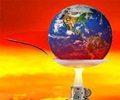An Australian researcher has determined that plants closer to the equator are more likely to have larger seeds, a fact that could help predict the risk that climate change poses to native plants.
An Australian researcher has determined that plants closer to the equator are more likely to have larger seeds, a fact that could help predict the risk that climate change poses to native plants.
According to a report by ABC News, the researcher in question is evolutionary biologist Angela Moles from the University of New South Wales in Australia, whose research looks at how climate and other factors influence plant traits across the world.Moles argues that a better understanding of the impact of climate on plant traits will help pinpoint which plants have traits that will be an advantage or disadvantage under future climate changes.
"A lot of the time we just protect them in national parks and hope for the best but with all of these changes happening it's not clear that is going to work," she said.
Moles and colleagues searched the literature on more than 11,000 species of native plants from around the world to identify what factors influence the size of their seeds.
As part of her research, Moles spent two years backpacking her way through 75 study sites around the world including China, Patagonia, the Republic of Congo and Greenland collecting other information to feed into a large database on native plant traits.
During this trip, Moles and her colleagues recorded plant height, how the plants were being eaten by insects and other animals and information on plant defence mechanisms.
"Seeds are 320 times bigger at the equator than at 60 degree latitude," said Moles.
These seeds are typically found in fleshy fruits and are dispersed by big animals, ranging from monkeys to giant birds, which are also more plentiful in the tropics.
By contrast in the Arctic, seeds tend to be small and wind-dispersed.
According to Moles, the largest seeds are those of the double coconut, which weigh up to 27 kilograms (60 pounds) each.
"The smallest seeds are those of orchids, which look like little bits of dust, and weigh less than a millionth of a gram," she said.
Source-ANI
LIN/SK
 MEDINDIA
MEDINDIA


 Email
Email






